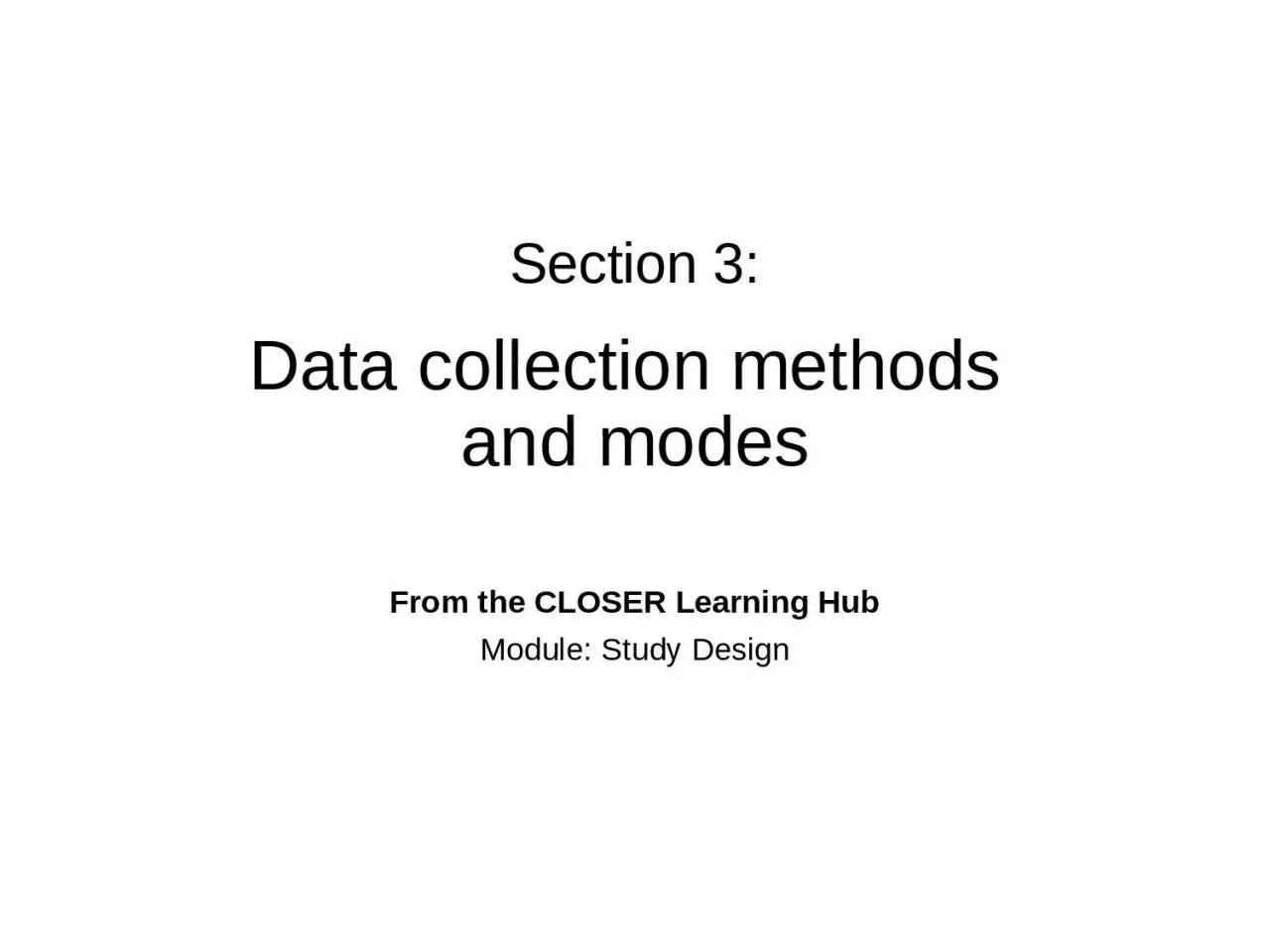

and modes From the CLOSER Learning Hub Module Study Design Data collection instruments Different tools used to collect different types of information eg questionnaires health assessments cognitive tests ID: 1033620
Download Presentation The PPT/PDF document "Section 3: Data collection methods" is the property of its rightful owner. Permission is granted to download and print the materials on this web site for personal, non-commercial use only, and to display it on your personal computer provided you do not modify the materials and that you retain all copyright notices contained in the materials. By downloading content from our website, you accept the terms of this agreement.
1. Section 3: Data collection methods and modesFrom the CLOSER Learning HubModule: Study Design
2. Data collection instrumentsDifferent tools used to collect different types of information (e.g. questionnaires, health assessments, cognitive tests)Respondents: studies may use the same or different instruments with different respondents (e.g. participant, parent, partner)Challenge: do new and improved instruments collect comparable data as older instruments?
3. Example: Millennium Cohort Study2001-032003-05200620082012-132014-159 months3571114MotherMotherMotherMotherMotherCohort memberFatherCohort memberFatherOlder siblingsCohort memberFatherOlder siblingsTeacherCohort memberFatherTeacherCohort memberFatherTeacherParentsQuestionnairesQuestionnairesCognitive assessmentsPhysical measurementsCheek swabQuestionnairesCognitive assessmentsPhysical measurementsQuestionnairesCognitive assessmentsPhysical measurementsActivity monitorMilk teethQuestionnairesCognitive assessmentsPhysical measurementsQuestionnairesCognitive assessmentsPhysical measurementsTime diaryActivity monitorSaliva samples18,55215,59015,24613,85713,28711,726main respondentsecondary respondentssurvey instrumentsresponse
4. QuestionnairesMost common data collection instrumentCan be administered by interviewer or by self-completionQuestion types can include:Yes/noDiaries or event calendarsOpen questions
5. Cognitive assessmentsExercises that test how participants think and how their minds are developing (or declining)Standardised assessments such as British Ability ScalesMust be age-appropriate
6. Example: Vocabulary testVocabulary is an aspect of cognitive ability1970 British Cohort Study gave a vocabulary test at age 16 – participants were asked to give the meanings of wordsGiven the same test at age 42 to see how vocabulary had changedResearchers compared vocabulary scores to lifelong reading habits
7. Health assessmentsCommon health measures include height, weight, blood pressureStudies may periodically carry out more in-depth health assessments including lung function, heart rate, balance, grip strengthHealth assessments often carried out by nurses in participants’ homes or in clinics
8. Assessments of mental health and wellbeingTypically take the form of sets of questionsStandardised assessments such as the Strengths and Difficulties QuestionnaireParticipants answers to multiple questions pooled to create an aggregate score for psychological distress or wellbeing
9. Example: Malaise InventoryDo you feel tired most of the time?Do you often feel miserable or depressed?Do you often get worried about things?Do you often get into a violent rage?Do you often suddenly become scared for no reason?Are you easily upset or irritated?Are you constantly keyed up and jittery?Does every little thing get on your nerves?Does your heart often race like mad?
10. Biological samplesBlood, saliva, hair, milk teethGenetic information is extracted from samplesBiomarkers: objective measures of healthSome studies collect biological samples from parents and children, allowing for studies of how genetic risk is passed between generations
11. Qualitative informationOpen-ended questionsIn-depth interviewsEssays or other writing tasksQualitative instruments used to gather information about subjects that are difficult to capture through quantitative means, for example social identity, future plans, feelings
12. Example: 1958 British birth cohortImagine you are 25…essays written in 1965 at age 11 (13,600 responses)Imagine you are 60…essays written in 2008 at age 50 (7,400 responses)90-minute in-depth qualitative interviews carried out with 230 participants at age 50
13. Modes of data collectionMode: method by which the data collection instruments are administeredFace-to-faceTelephonePostOnline
14. Mixing modes of data collectionMost studies use a mixture of modesVarying mode by sweep: e.g. carrying out one survey face-to-face and next by phoneVarying within sweep: e.g. collecting some info by postal questionnaire and some in face-to-face interview, or asking some participants to take part online and others through face-to-face interviewsCombining modes can save costs, however can also introduce measurement error
15. Linking to government recordsEnhance study info by asking for consent to link to government administrative records, e.g. Key Stage scores, tax and benefits records, or hospital admittanceSome studies use linked data as fundamental part of study designFuture linkage could include social media accounts, store rewards cards, smart energy readers